
Miramichi Fishing Wrap Up Autumn 2019
Fishing Friends – the 2019 Atlantic salmon season ended on the lower Miramichi and Cains Rivers on October 15. I’d been in Blackville since September 5th, and while that is a long time to be in camp, I enjoyed every minute, and the unbroken stretch provided a good perspective of how the fall run developed on these rivers. I had a line in the water some portion of every day during that period.
I’m not going to report in this blog entry on the trap numbers for the 2019 season. We have a Miramichi Salmon Association board meeting on November 2nd where we will get Mark Hambrook’s take on the season’s statistics, plus I want to see the final numbers from the traps from October 31. After that I will write a blog entry that discusses the timing and strength of the Atlantic salmon run in the Miramichi for the whole season in review. In this blog entry I’m going to focus on how the fall fishing unfolded on the lower Miramichi and Cains Rivers.
August 31 – September 4 CLICK ON PHOTOS FOR FULL SIZE EXPANSION
By Labor Day weekend, after another warm, dry summer, the river was low at around .55 meters, but at fishably cool temperatures of high teens C or mid to high 60sF. Summer fish were holding in a few downriver low water pools, and the cold water buffered pools still had their population of fish. The lower Cains pools as far up as Salmon Brook, and Black Brook’s Pool at the mouth of Cains all had a fair to good number of resident holding fish. We were looking forward to seeing what the fall run would bring in, and were somewhat optimistic given that grilse numbers were up in the early summer counts, and large salmon were equal to 2018 which turned out to be an ok year for them.
Over Labor Day week anglers for the two trips that I had donated to the MSA fished the Campbell’s Pool waters including Doctor’s Island and the Brophy Pool. They caught mostly grilse, but, with the help of MSA USA president, Andy Dumaine, Zach Sheller of the Downeast Salmon Federation caught his first salmon of approximately 10 pounds at DI plus lost another and also had a grilse!
September 5 – September 7
After arriving at Campbell’s I caught my first fish of the fall at Brophy. It was a grilse on a green and orange bomber in 21C/70F water that was the season’s lowest at .53 meters on the Blackville gauge.
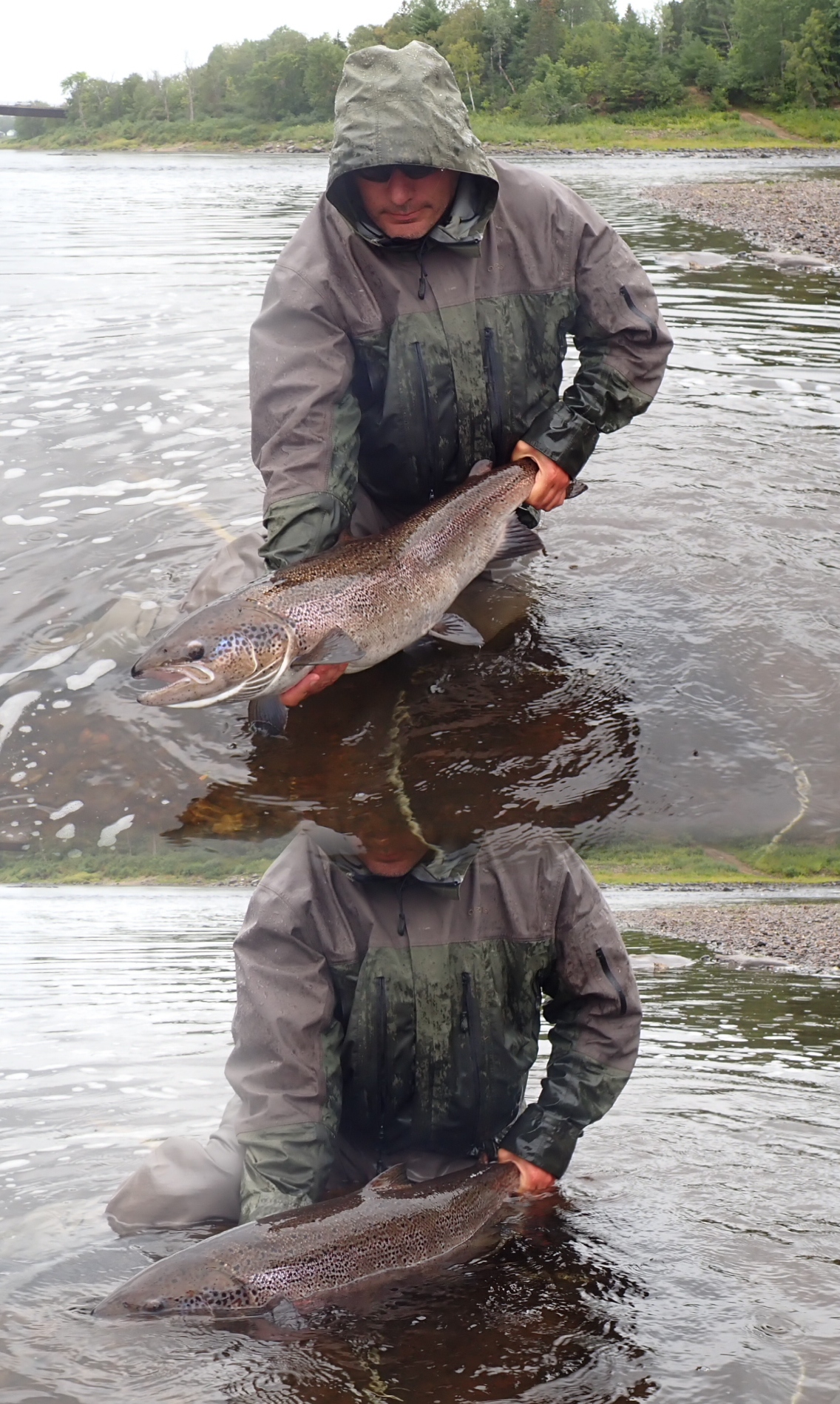
I don’t know exactly what happened to this photo, but I thought it was kind of cool, so here is the same fish from a couple of angles!
On September 10th, during the beginning of the rains from Dorian, I caught one of my larger salmon for the fall, an estimated 18-pound henfish from a low water lie at the bottom of Doctor’s Island in a water height of .54 meters. It was on a #8 Undertaker. We would not see water that low again all fall. Dorian dumped about 3 ½ inches on the Cains River headwaters, and two inches in the SW Miramichi highlands. The river rose 1.7 meters to reach a height of 2.2 meters on the Blackville gauge.
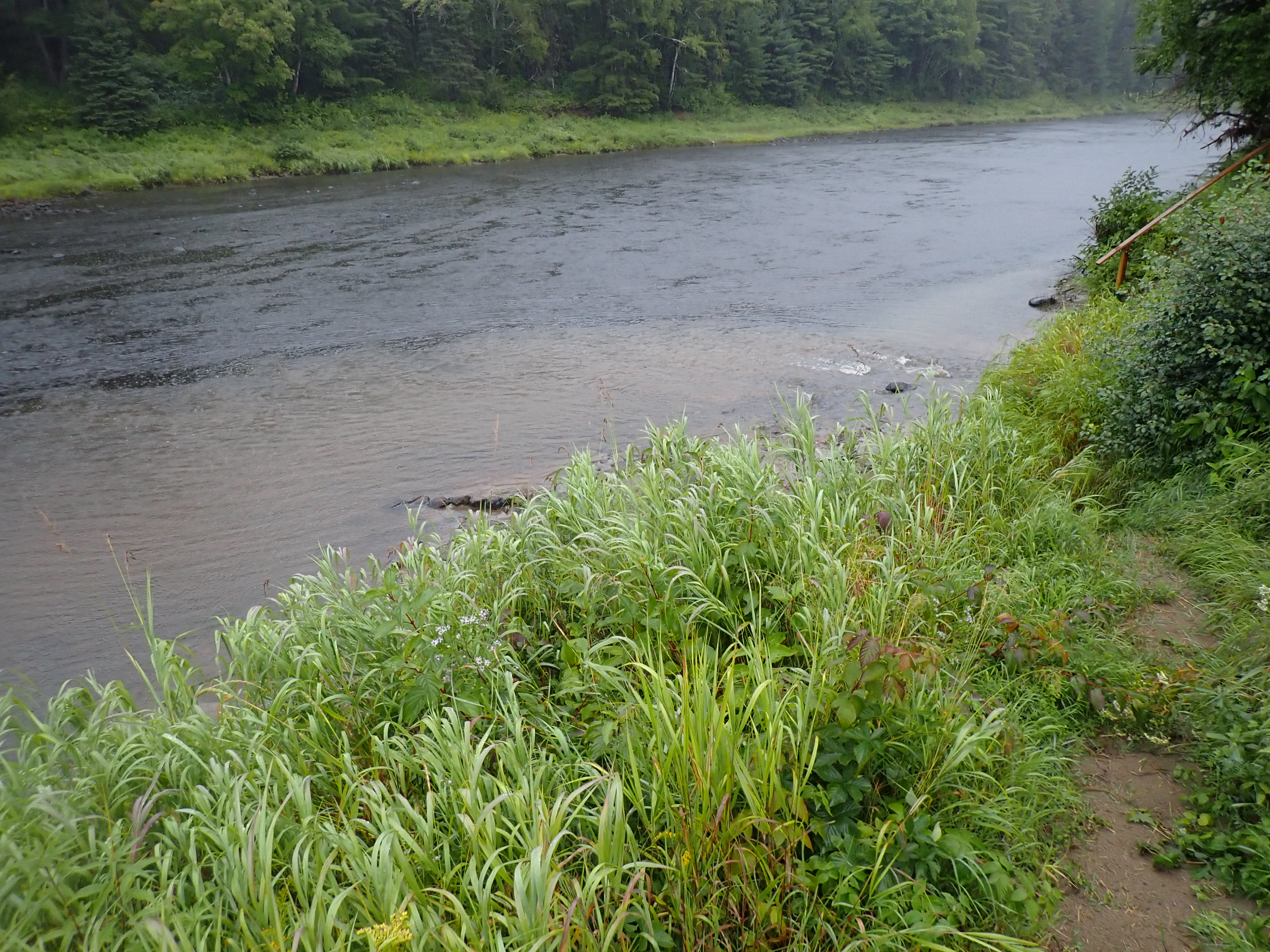
Thanks to Provincial government apparent indifference here is Otter Brook spewing silt into the Cains River.
I caught the fish at Doctor’s Island in heavy rain. Jason Curtis and I had gone down to bring back the canoe that we keep there, and to move the benches and rod racks to higher ground. I decided to check out Brophy in the afternoon. Darrell Warren and I drove out the East Brophy Road which was covered with water. When we got to the Brophy Pool, Otter Brook was pouring mud and sand out into the middle of the river. The lack of Provincial maintenance on both the Shinnickburn and Brophy Roads, coupled with people illegally driving through the stream now that the bridge is gone has caused a lot of extra silt to go into this stream that the salmon so heavily depend on. I have complained loud and long about this to DTI and Environment, and I will continue to do so.
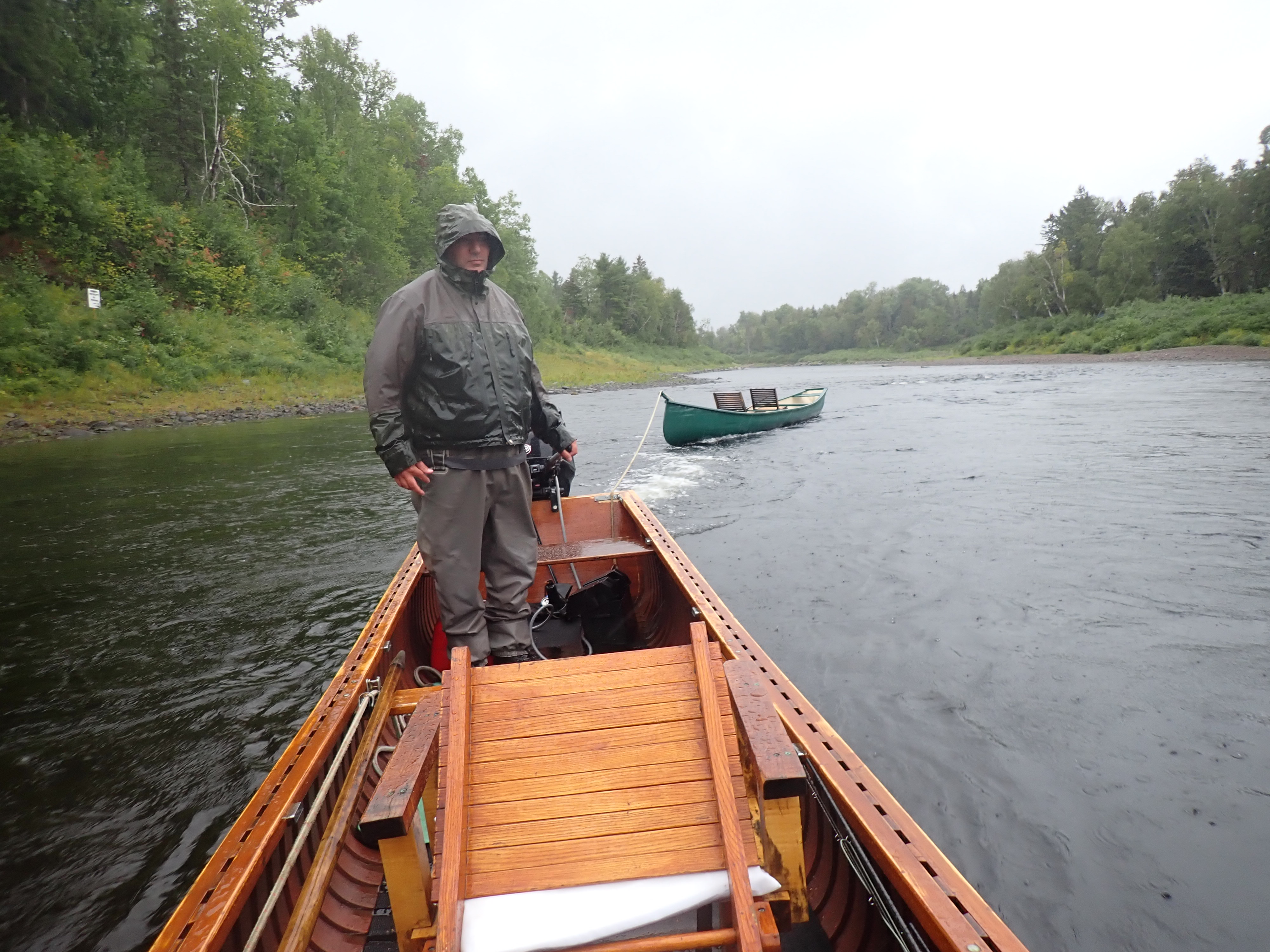
Jason Curtis towing the Doctor’s Island bar canoe up through the Goose Island thoroughfare during the Dorian rain.
The salmon that were holding in the pool had moved over against the far bank and well down into the pool, and they were doing a lot of jumping. I don’t know that I have ever seen rain fall as hard as that afternoon. It seemed like someone was pouring it on us from a bucket. On many of the casts I made that afternoon using a large, bright orange marabou fly I had nipping strikes, but could not get a hookup. Finally I did hook a large salmon that came unhooked long before it was ready to land. Friends down at Black Brook had all caught limits of salmon that morning. I should have been up at Brophy much earlier in the day. I count that as the biggest missed opportunity for me of the fall.
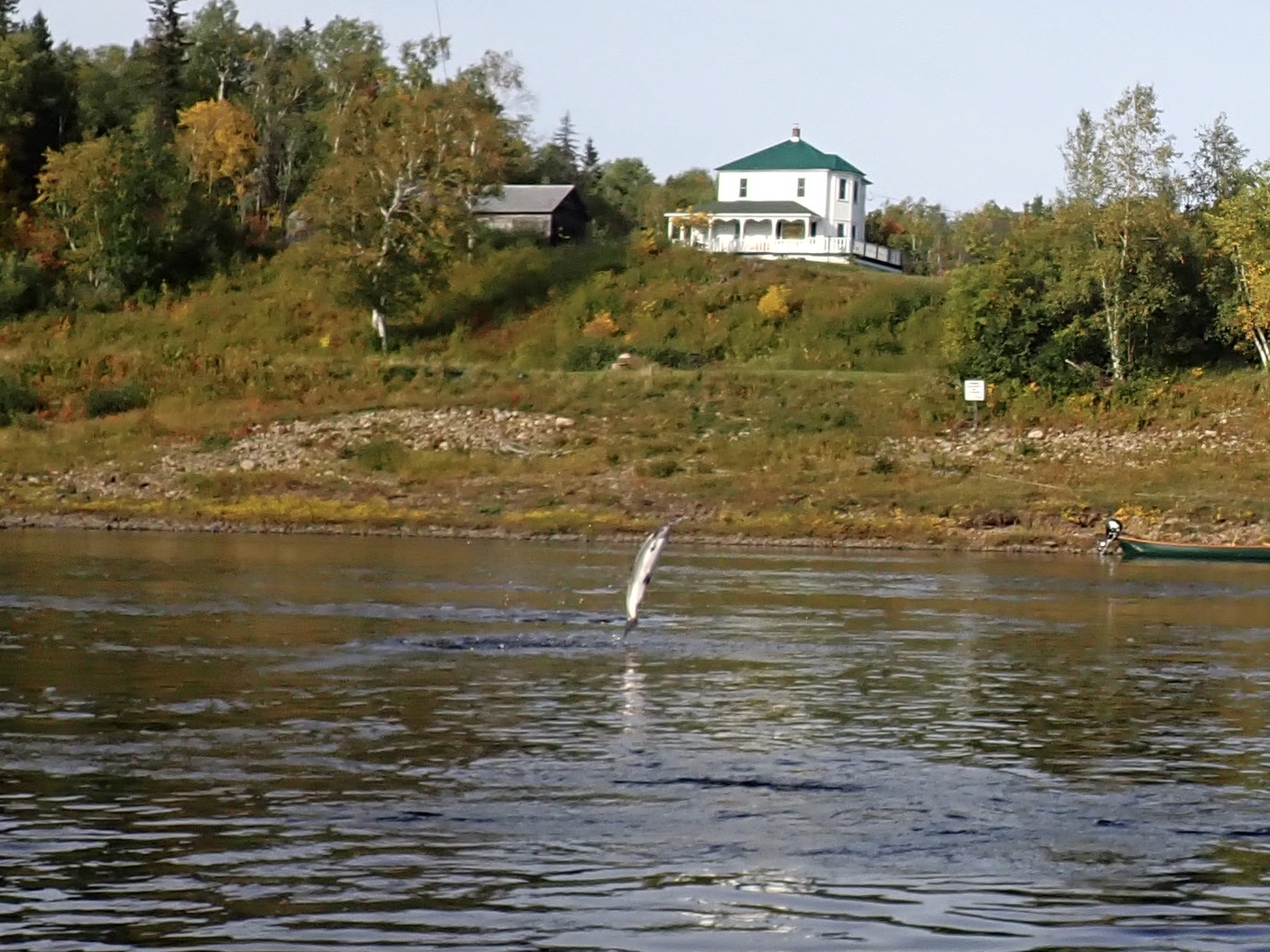
This acrobatic salmon appeared unhindered by its radio tag and antenna.
September 10 – September 23 By the 10th the SWMiramichi was clearing up, and had fallen to a somewhat fishable level of 1.5 meters. We began a near two week period of fishing on consistently dropping water. The big raise also reduced the water temperature into the high 50sF, and it never got back into the 60s again for the rest of the season. Looking back on things, this was some of the most consistent fishing that we had all fall. According to my logbook we caught fish on all but two days of this two week stretch, though there were never a lot of fish present. It was what I would call a steady trickle. There was really no point during this period of time when fishing was either really poor or really good. Every session we would see a few fish jump as they progressed up the river, and if you diligently worked down through the lies in the pool you would eventually find a fish or two.
The only session for me that really represented the kind of action we had a few years ago on the Miramichi was on September 12th, on the upper end of the Brophy Pool. I hooked seven salmon and grilse that morning – landing only two. I believe that these were fish that had been holding at Black Brook and the lower end of Brophy Pool, and were in the process of heading upriver.
Among the fish that we caught in this stretch were three fish that had been tagged at Millerton, one was a grilse, and the two salmon had estimated weights of 12 and 13 pounds. One salmon had been tagged at Millerton on July 16th, but the other two were each caught at Campbell’s Pool in Blackville 5 days after being tagged at Millerton. One of them had a radio tag trailing a thin wire antenna in addition to the blue numbered tag. I felt a little sorry for the fish carrying all that stuff, but it actually put on one of the more spectacular fights that I experienced all fall.
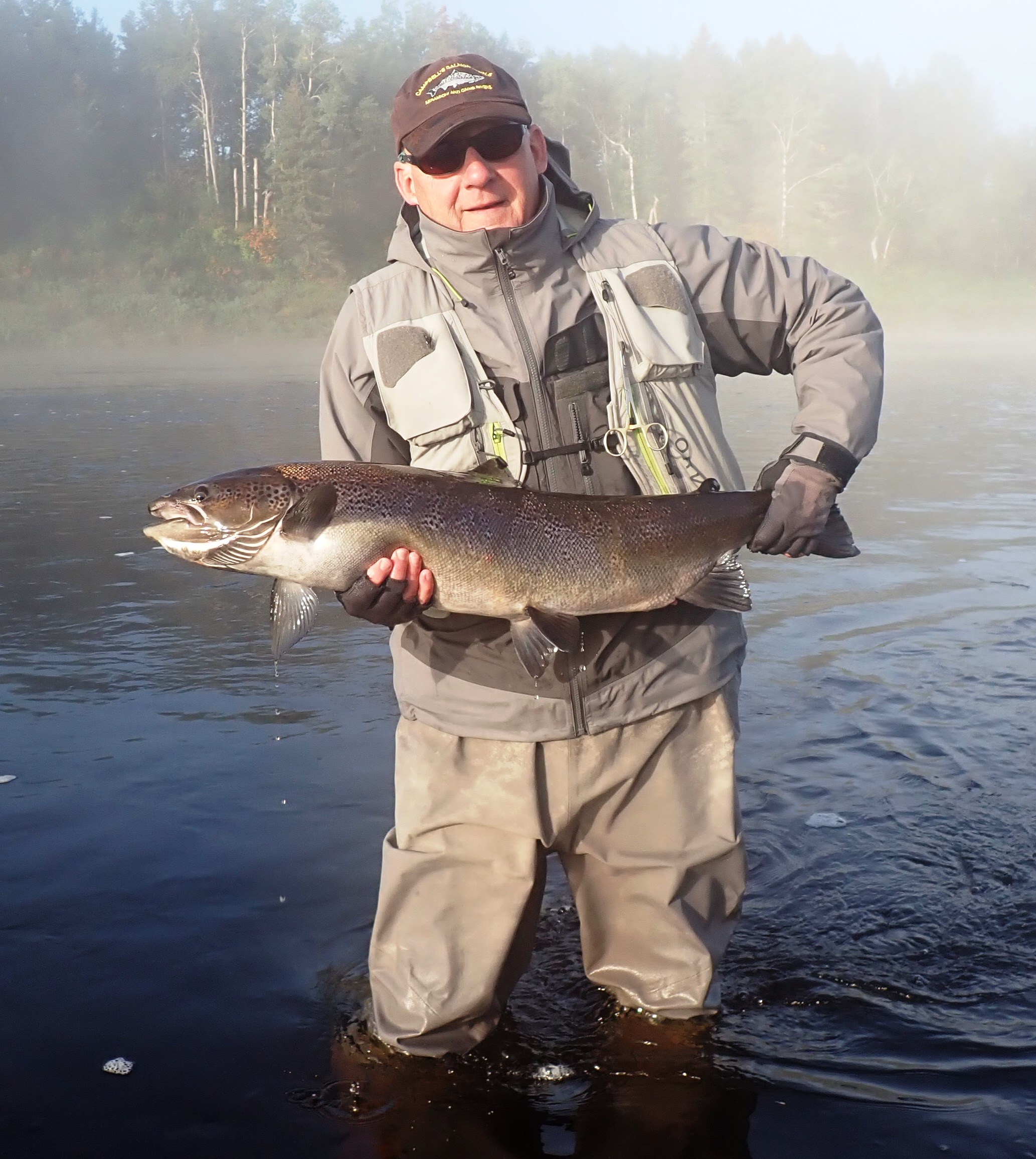
This nice hen salmon, perhaps my largest of the fall, went for a #8 Ally’s Shrimp in the morning fog on 9/18.
September 24 – September 30
On September 23rd we got our second large rainstorm of the month and the Miramichi and Cains both began to rise rapidly. We saw almost nothing during this raise in water – I assume because there simply were very few fish either holding in the lower river or ready to come in from the estuary. The river had never gotten low enough to discourage new fish from coming in, or to hold them from just swimming on through. There was simply no pent-up demand. I got one lone grilse at a choke point near Doctor’s Island as the water rose past .8 meters on its way to 1.6.
To find clear water the next day, September 25, we went to our camp at Mahoney Brook, 20 miles up the Cains River. The rivers had barely crested, but the Cains that far up was already clean enough to fish, and we caught a grilse. We also got a couple more up there and lost two others during the next day or two, and that was the most September fish that we have caught that far up in the 10 years that we have owned the camp. Generally speaking we don’t see much up there until the end of the first week in October. One notable fish from this time frame was a mid-teen sized Cains River cock salmon caught by Harvey Wheeler of Maine. The fish took an October Killer up at Mahoney Brook.
With the dropping water we now eagerly anticipated a good push of late arriving fish, but as with the rest of this fall large numbers of fish just never materialized. Instead, other than the first couple of days on the Miramichi when we saw a small push of fish, we had the trickle we had experienced all September, but this time there were even fewer.
September 30 – October 15
That low level of incoming fish, many of them with sea lice, continued for the rest of the season. Some pools definitely did better than others, the Orr Pool down in the Rapids section of the Miramichi, the waters around the mouth of the Cains River, and couple of the best Cains pools like the Doctor’s Island Club pool at Muzzerol Brook, and the Moore Pool gave up a fish or at least a strike on most days, but overall it was very slim. I’m not as dialed in to further up the Miramichi, but I did hear of some somewhat better fishing up in the Doaktown to Boiestown area. Further up than that the season closes on September 30.
The word from everyone I spoke with, though, is that the upper river in the vicinity of Rocky and Clearwater Brooks held lots of fish this summer. Perhaps this is because of the good volume flow of cool water that we had through June and early July. We heard that Rocky Brook’s catch was up over 2018 by 300 fish! Great to hear the good news.
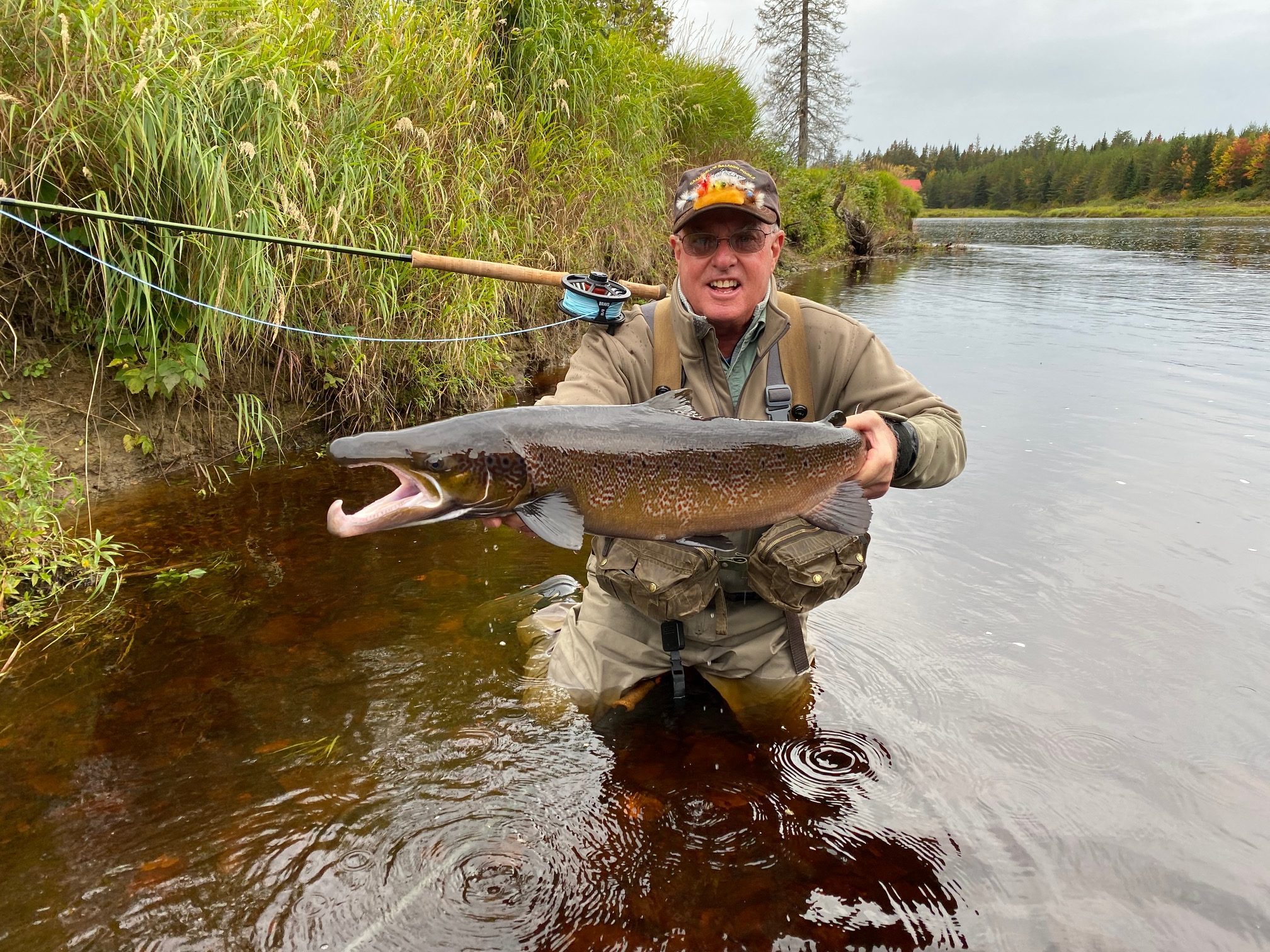
Harvey Wheeler “the Maven” with our best cock salmon of the fall. It was the special hat that did it…
One of the finer moments of the very late season was landing a really large hen salmon on October 12th in the Slow Pool about 20 miles up the Cains. This fish had been tagged at Millerton, and I have not yet received the measurements of the fish or the date it was tagged. It was over 40 inches long, though, and I had to rub slime off the tag to read the number. I suspect that the fish, like one from September, had been tagged back in July. This fish, was an exceptional fighter for the late season, and was all over the top of the water with all the vigor of a chrome-bright, sea-liced June salmon. I would love to show you a picture, but I left the camera in the macro mode to photo the tag, and the picture is blurry to the point of being indistinguishable.
On the night of October 16th – the day after the season closed – I got an e-mail from Darrell Warren who had gone into the Brophy Place to retrieve our benches and rod racks for the winter. While he was there he saw a number of salmon rise in the pool. That pool had been fished regularly the last couple of weeks of the season, and hardly any fish had been seen or caught. That’s the way it ended up. You had to put your time in and every now and then it paid off. One of my good fishing friends said that he had reached the point where he is grateful for any salmon that he catches. Amen to that.
Hot Flies
While I very much believe that you catch fish on the fly tied to the end of your line, some patterns, styles and sizes definitely do work better than others at certain times of the season and heights of water. We caught only a couple of fish on bombers during the first week September. We then caught only a half dozen or so on the traditional “small black flies” that worked so well in the 2018 low-water fall. We also had only two on Green Machines, but that is probably just because most of my fishing friends really just prefer to fish with more traditional styled flies. One guy got three on a Chief Needahbeh which has been his fall favorite since the 1970s. We caught nine on #6 and #8 Ally’s Shrimp flies, most of these when the water dropped off after Dorian’s raise. The greatest amount of fish caught on any single fly, about a dozen and a half, came on a #2 October Killer, which is a slightly modified Mickey Finn pattern bucktail streamer with the addition of black or orange feather wound Cascade style behind the eye of the hook. That fly is really hard to beat in the late season. We started catching fish on the October Killer this season on September 11. We also got a few in the slow water on a big Orange marabou fly that has incredible action in the slowest currents.
In the end our fall rod catch, in spite of not having any really big days, was slightly ahead of average. While there were definitely many less fish in the pools than we were used to just a few years ago, the continuous strong flow of cool water kept the fish moving up the river, and when you did intercept one on a lie it was very likely to be a taker.
All in all it is still impossible to beat the Miramichi. You don’t have to fly to Russia, spend $1,500 a day, or sit in a boat sharing a rod. You can still regularly catch salmon and grilse, sometimes experience some excellent action, and the real possibility of a hooking a very large Atlantic salmon is always there. Perhaps as important as the fishing is the stunning scenery, and charm of the old Miramichi salmon fishing culture. Now we just have to wait 6 months for our next opportunity to cast a fly on her waters.
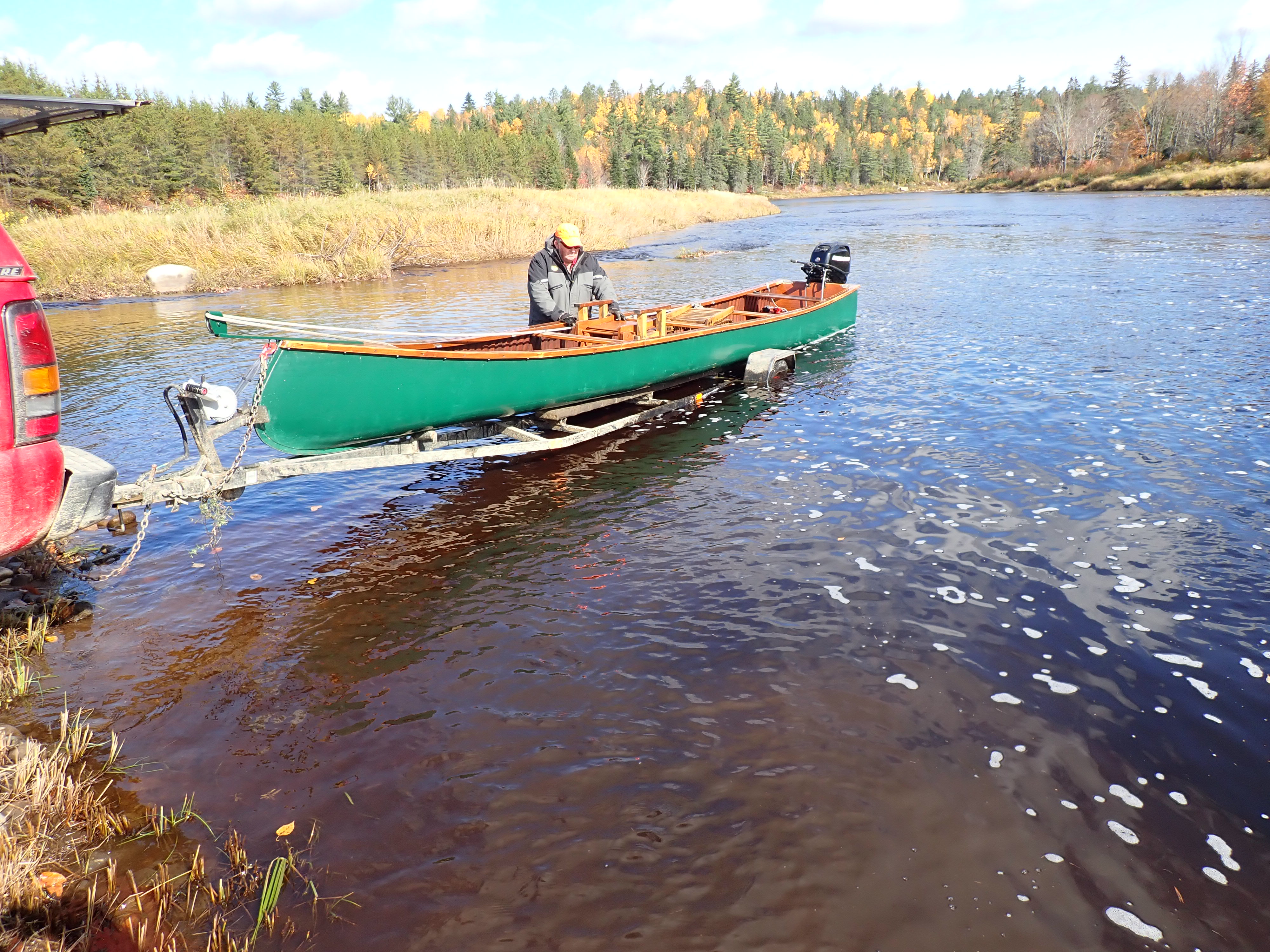
The season is over, and Darrell Warren secures a Sharpe jet canoe to the trailer for its final takeout of 2019.
Here’s a release video of the September 7th salmon from Doctor’s Island.
Miramichi Wildflowers
Speaking of Miramichi scenery, one of the delights that I enjoy every fall along the riverfront is the fall blooming wild flowers. I’ve yet to learn the proper names of these small but hardy beauties, but the varieties below were all photographed within a few feet of the bench at Campbell’s Pool.


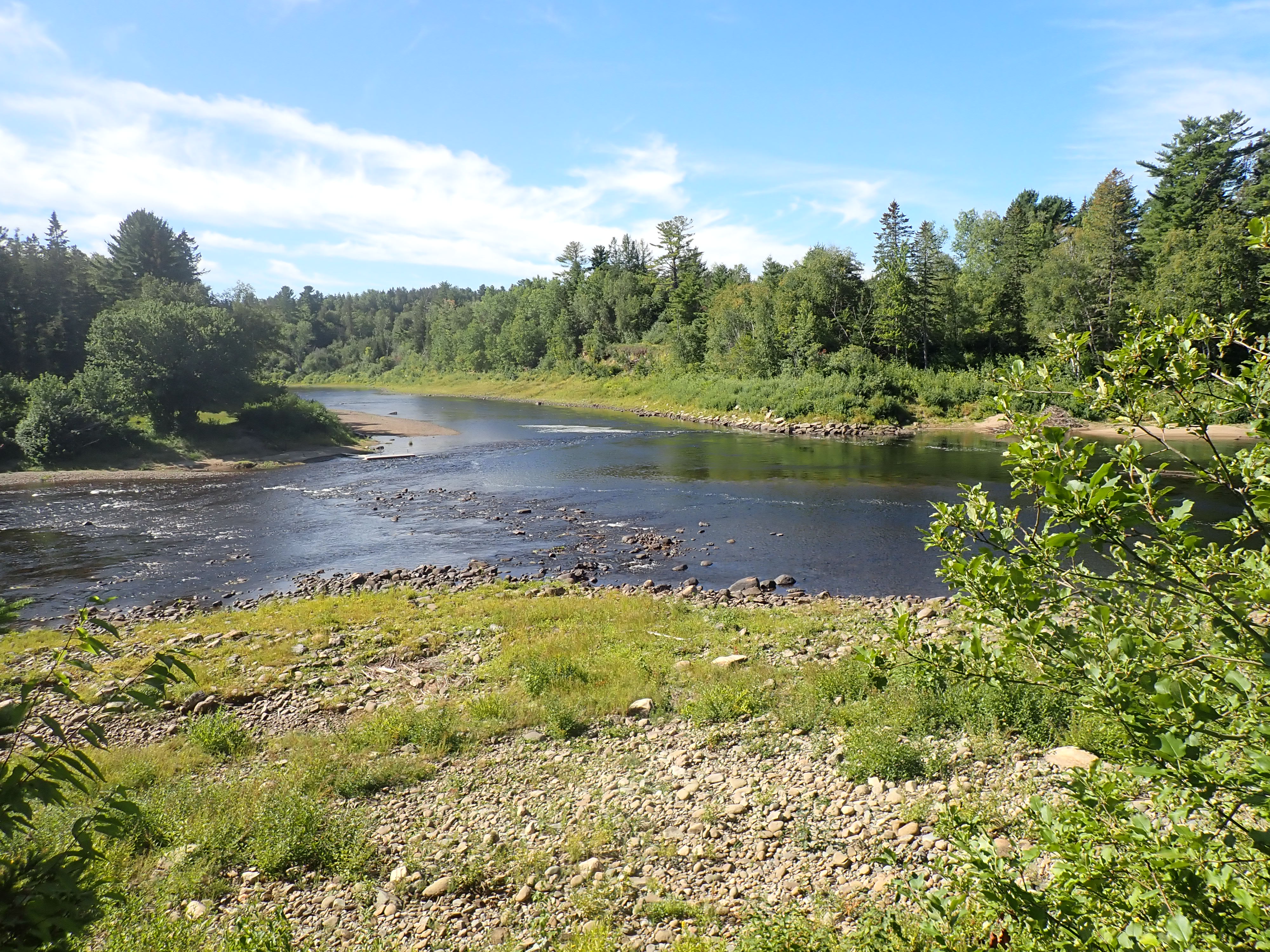
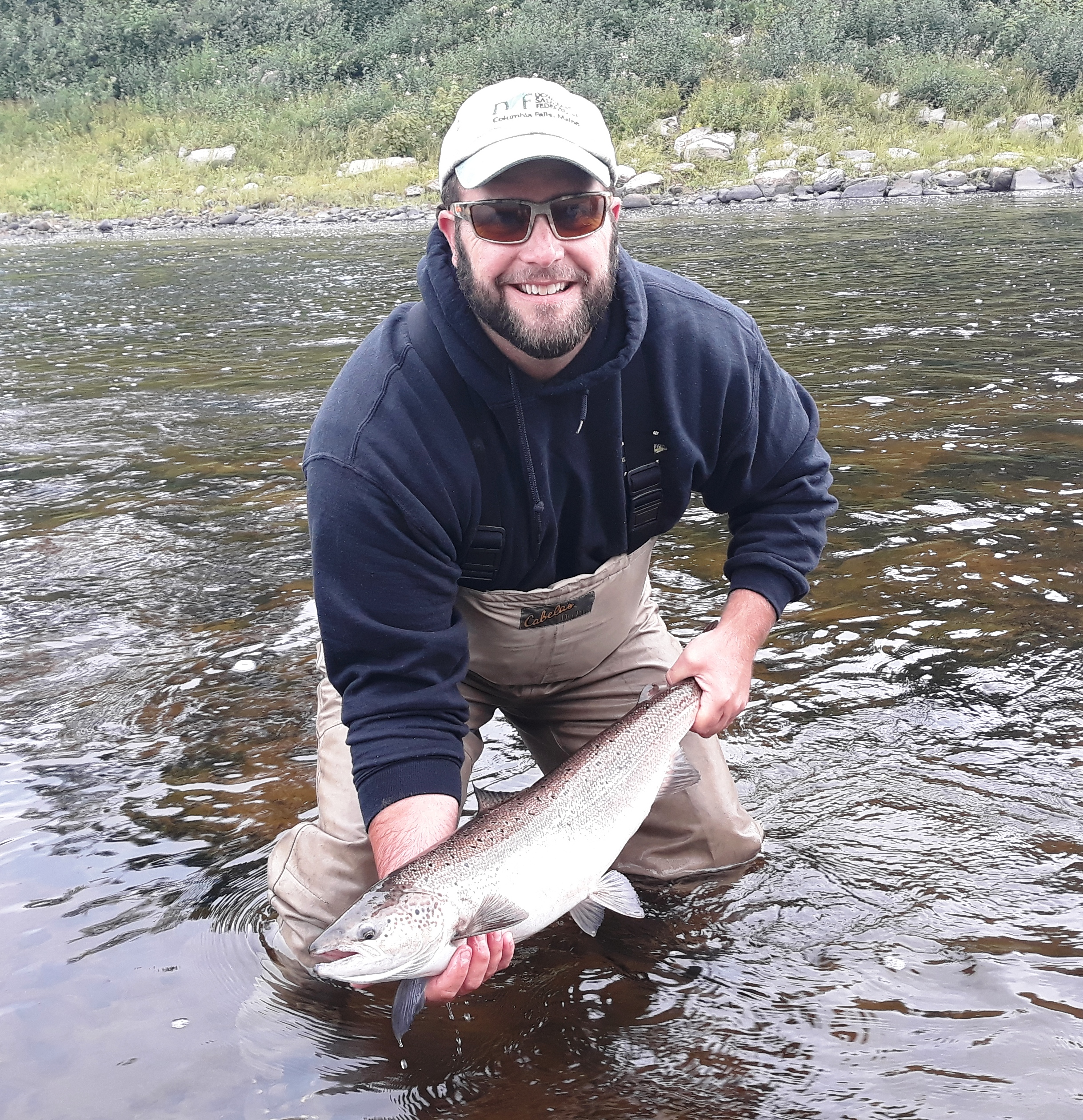
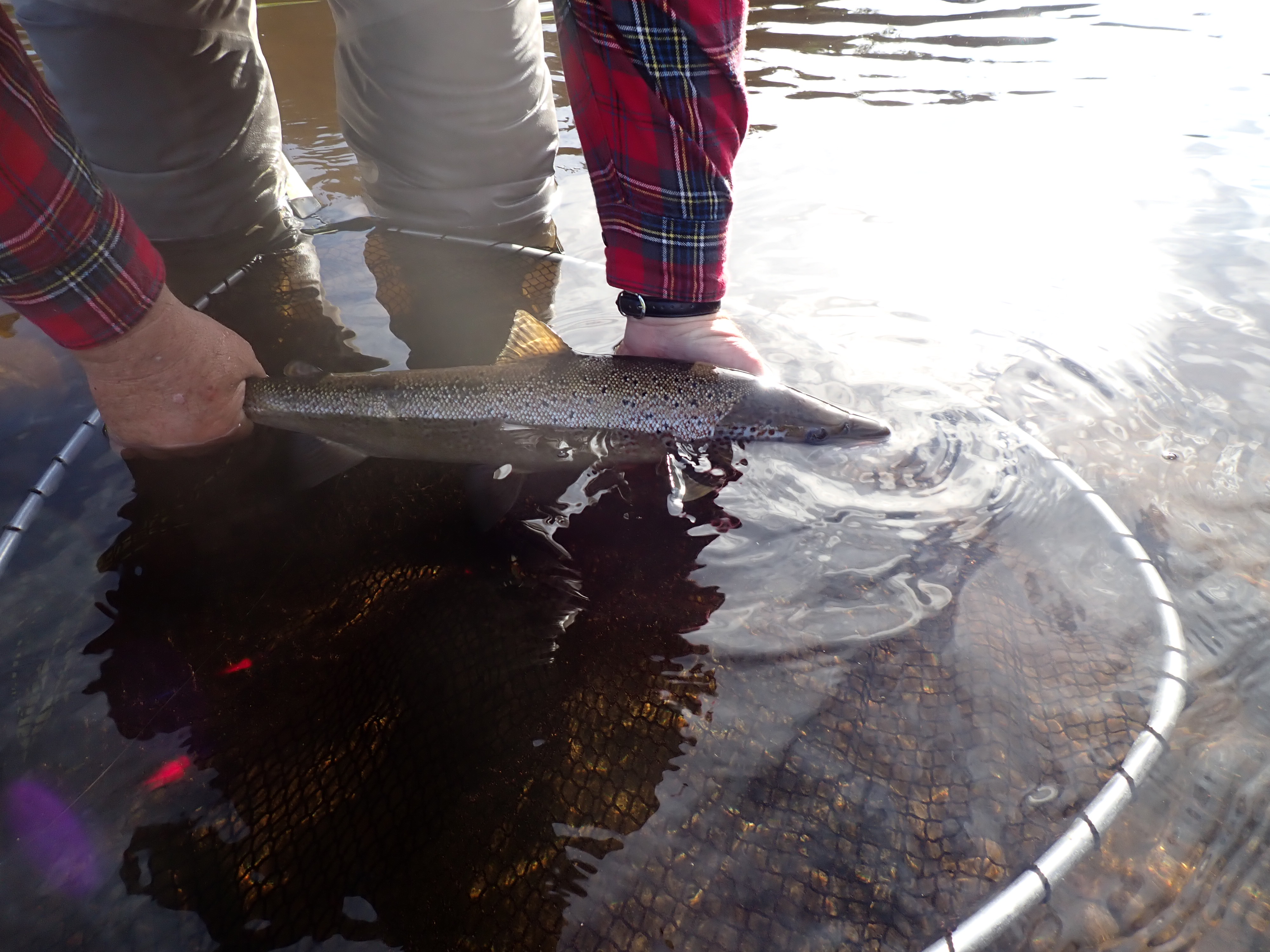
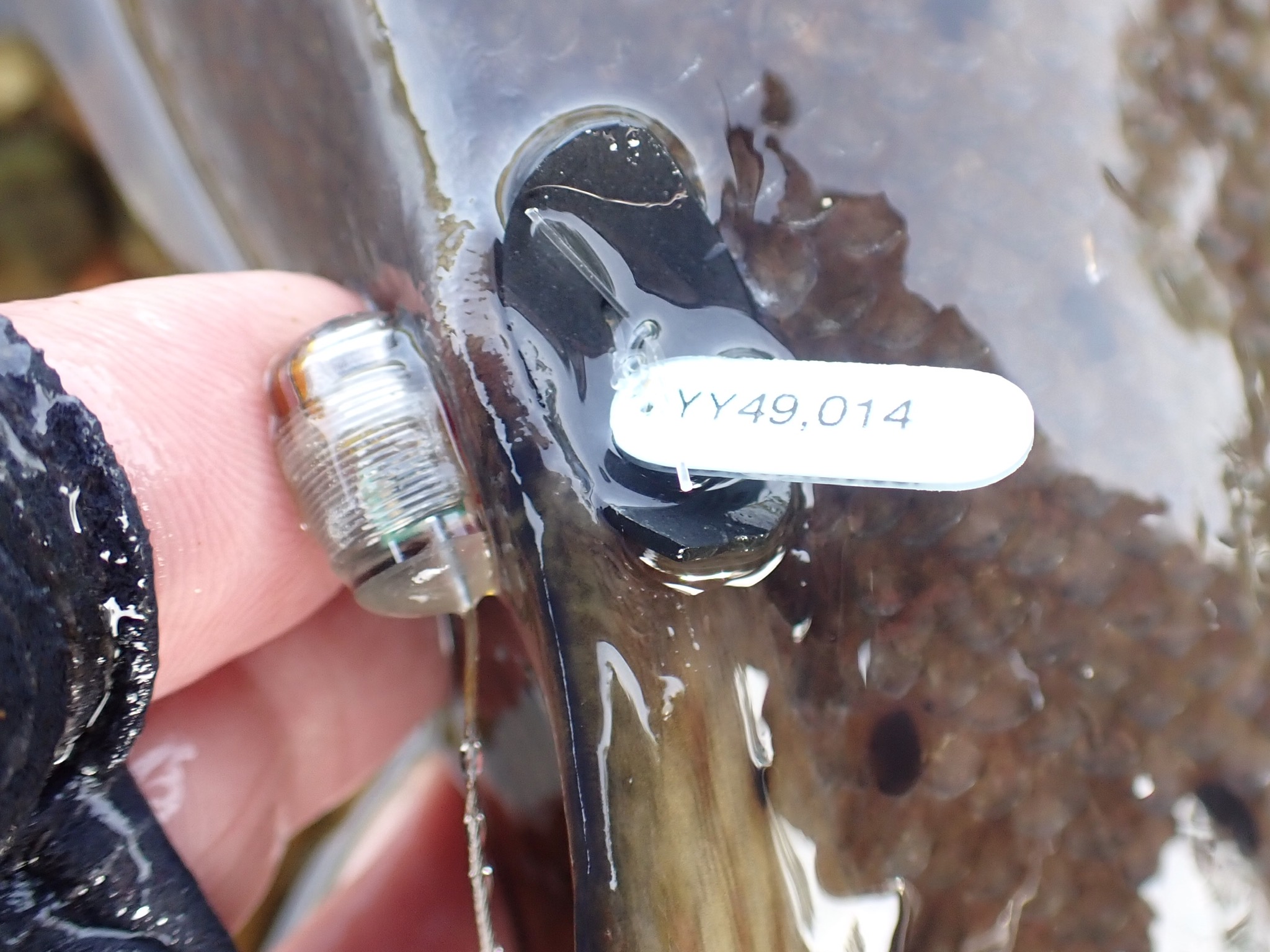
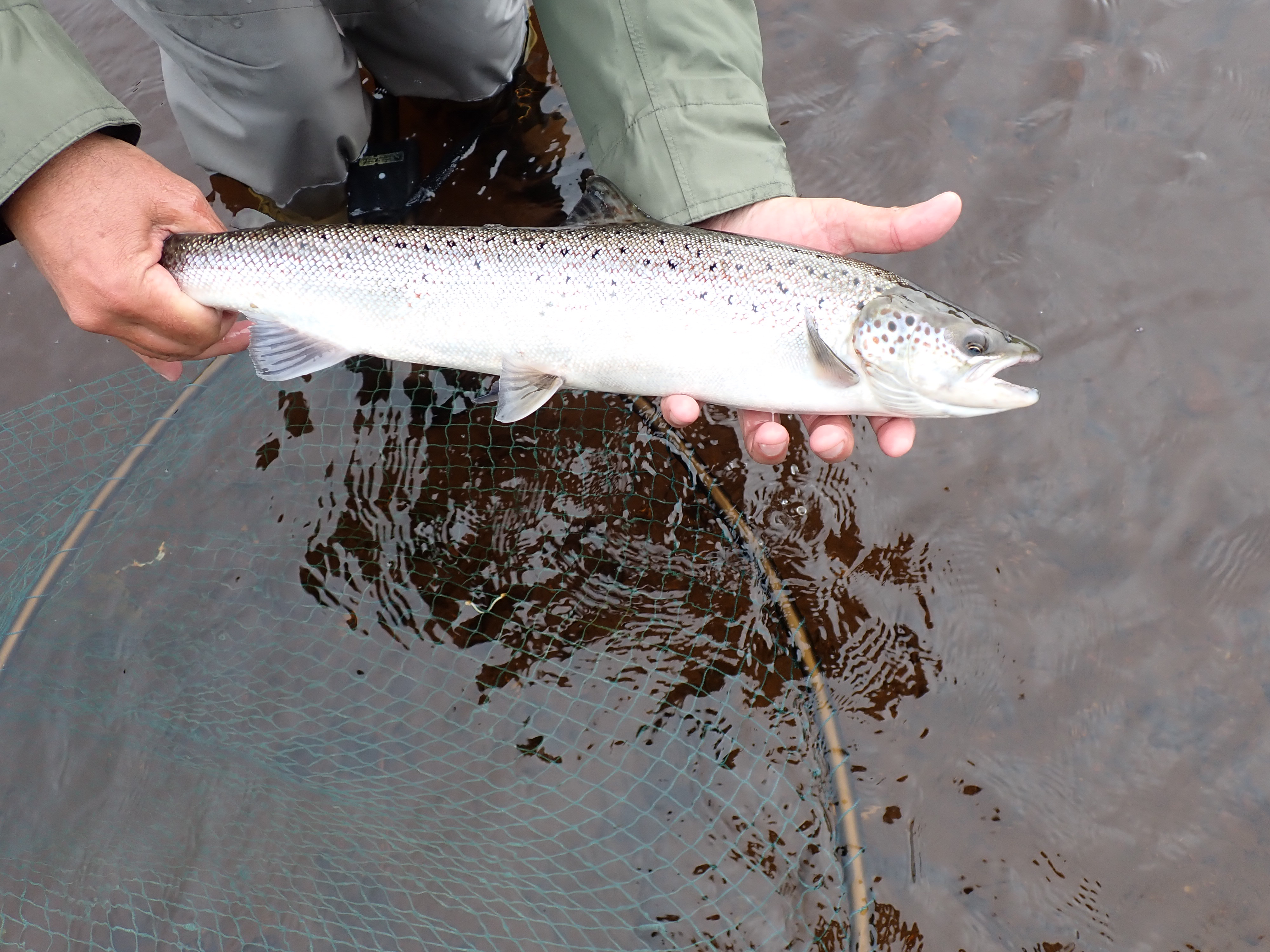
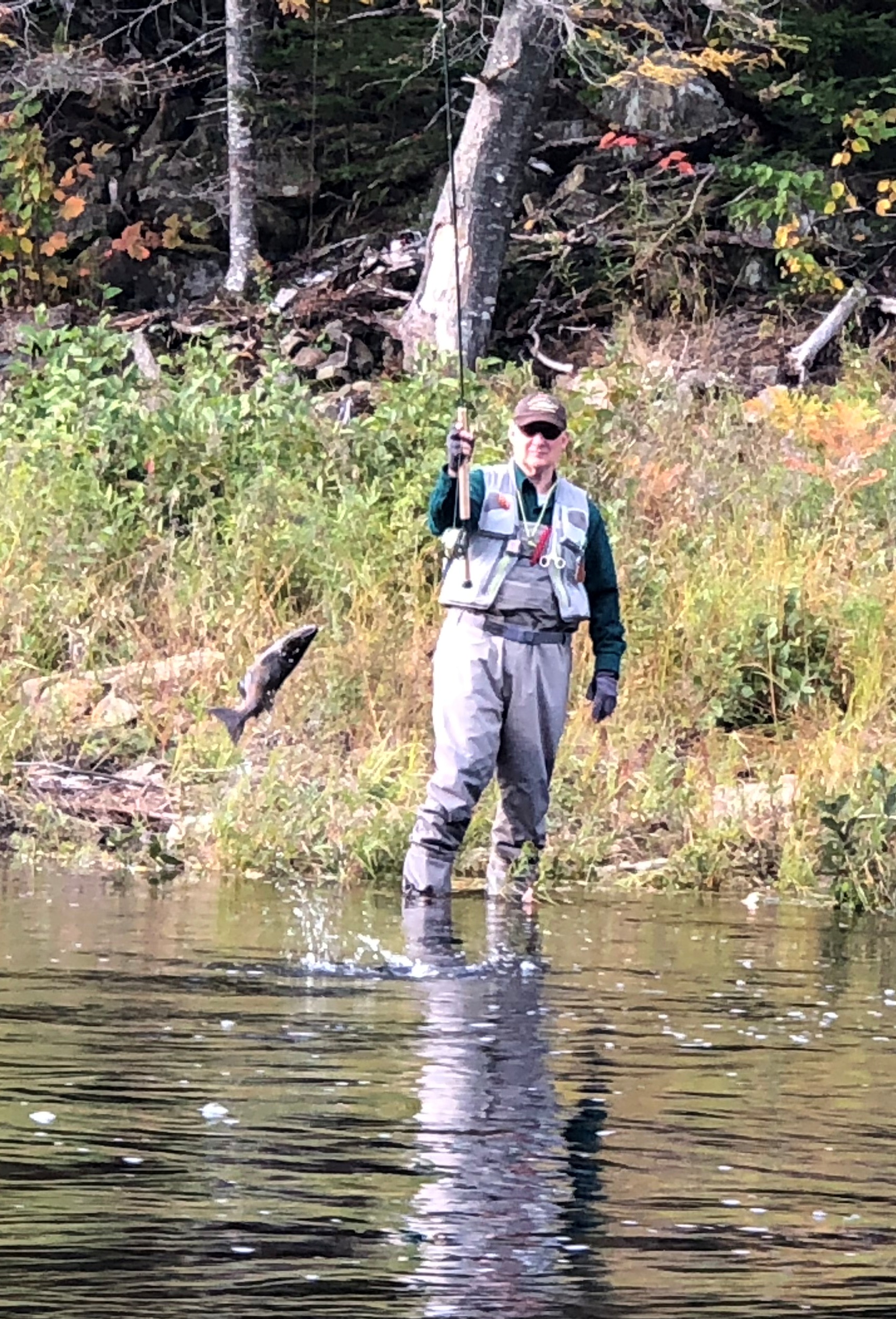
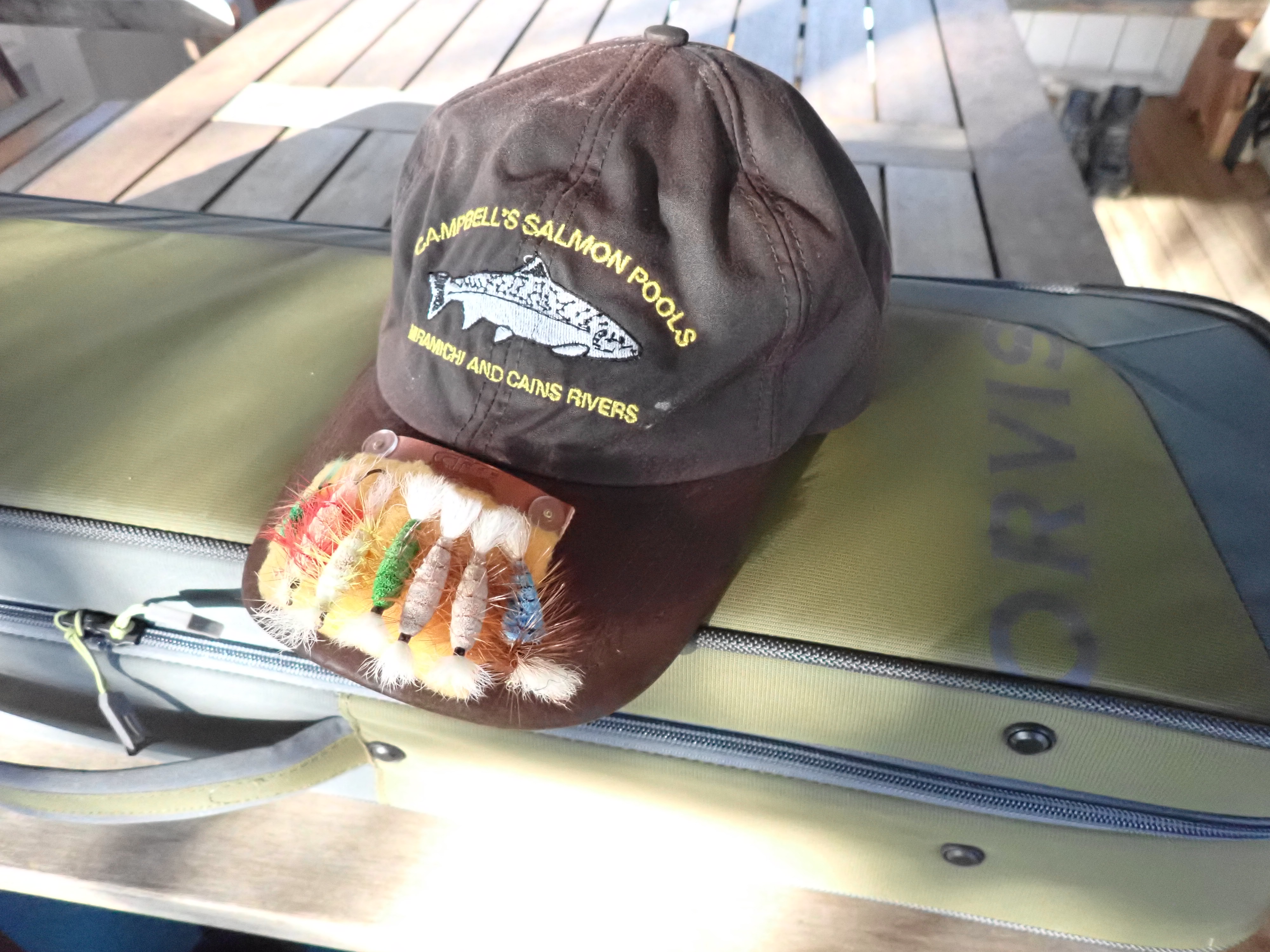
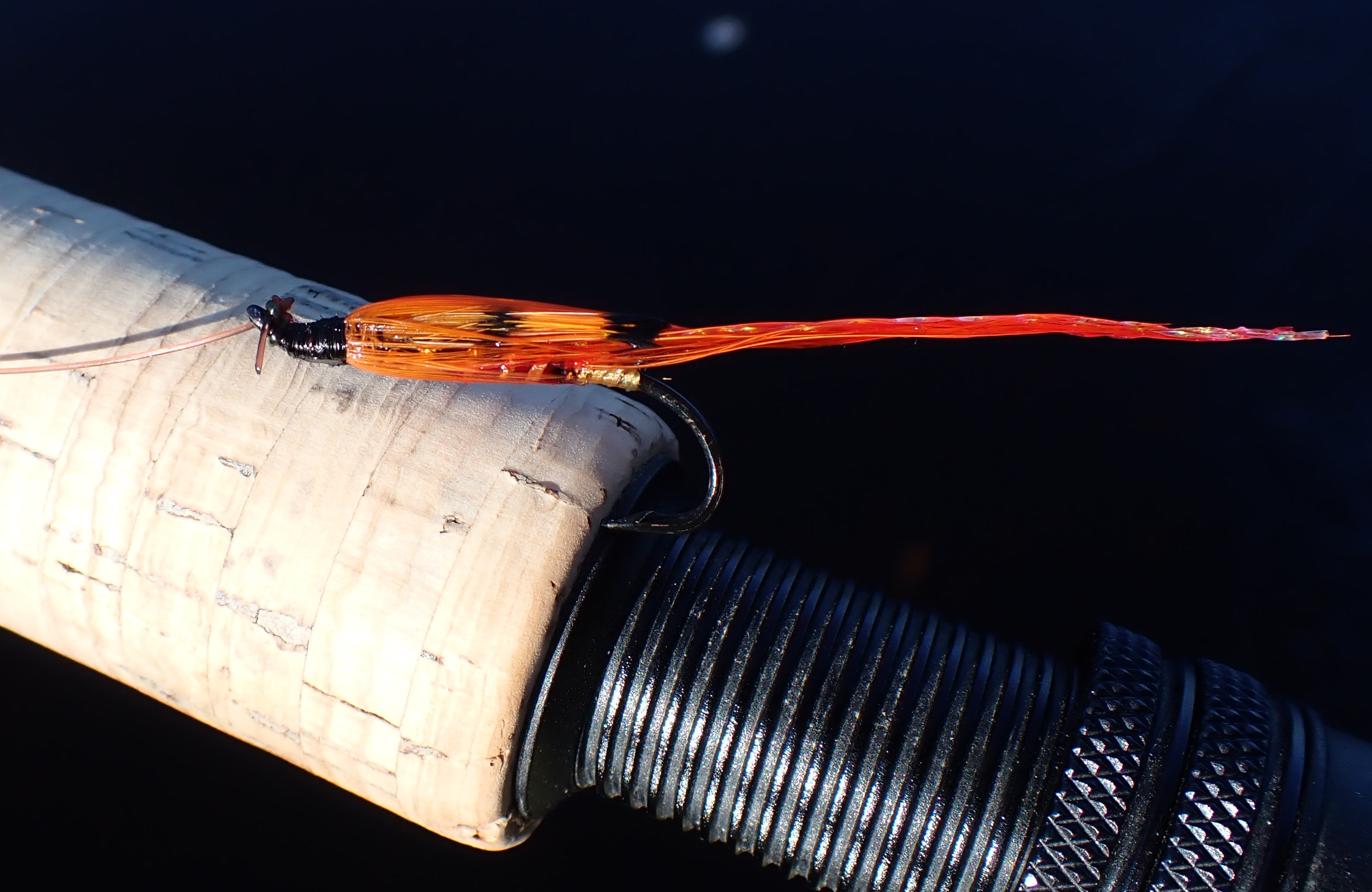
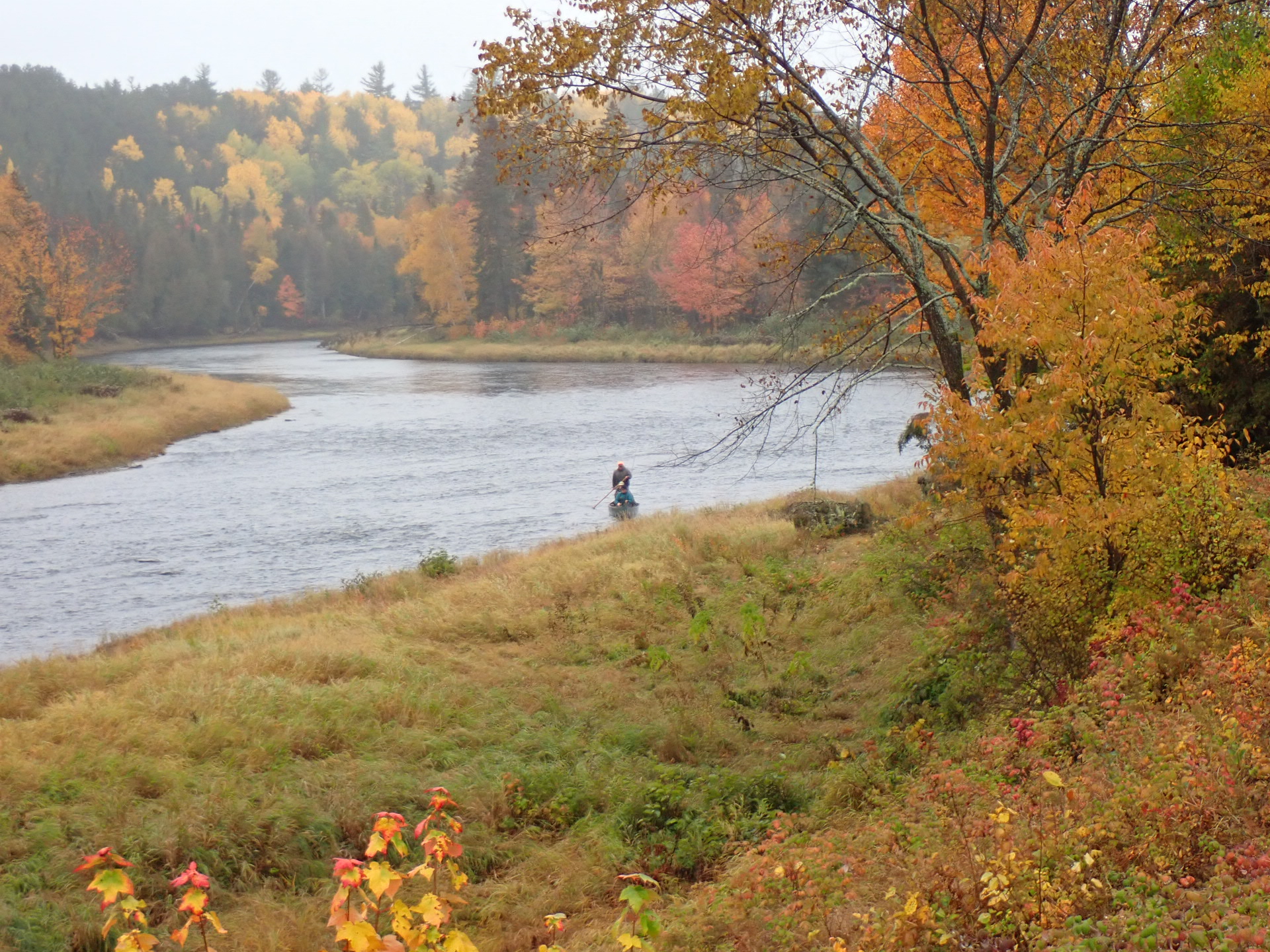
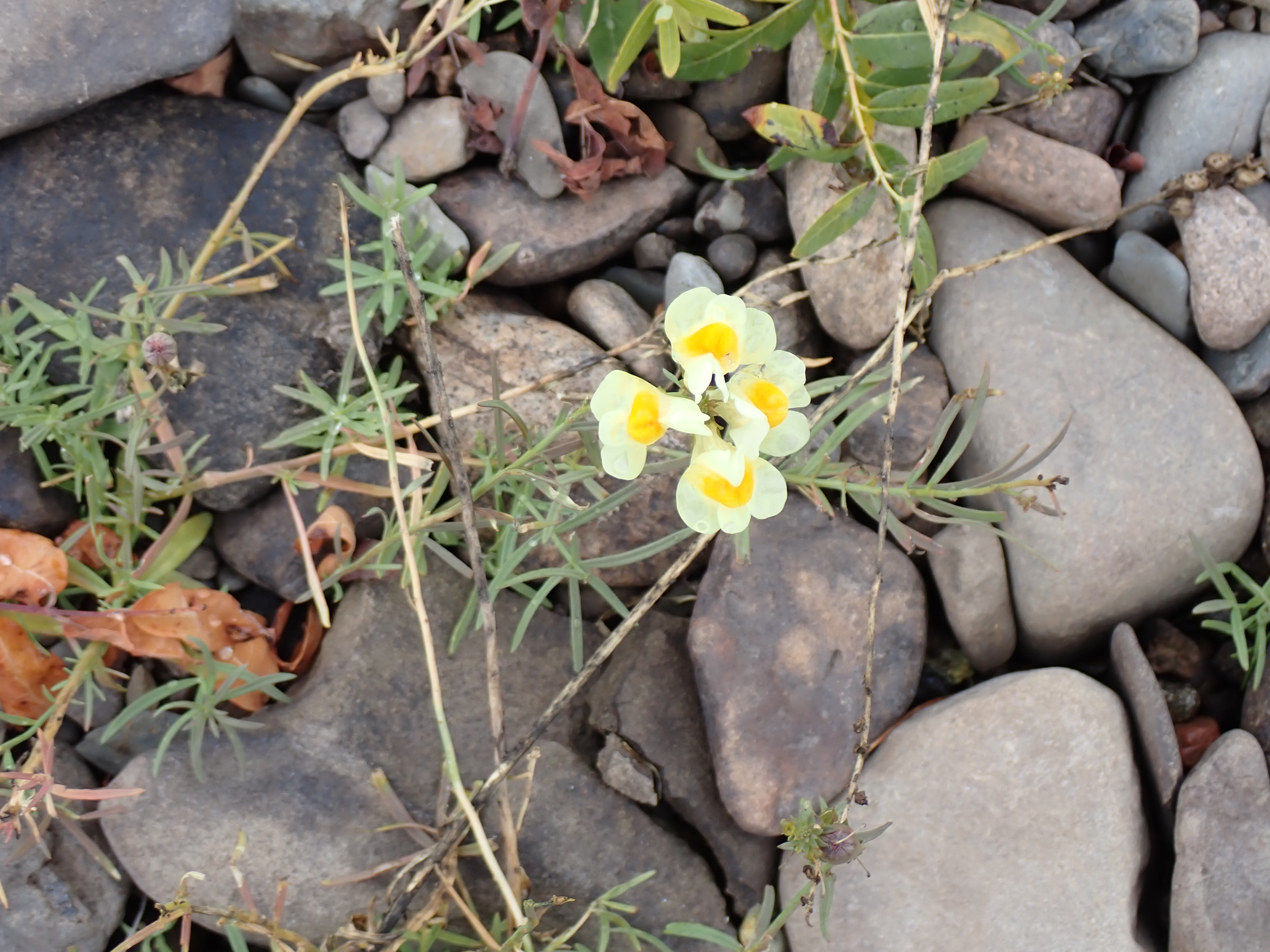
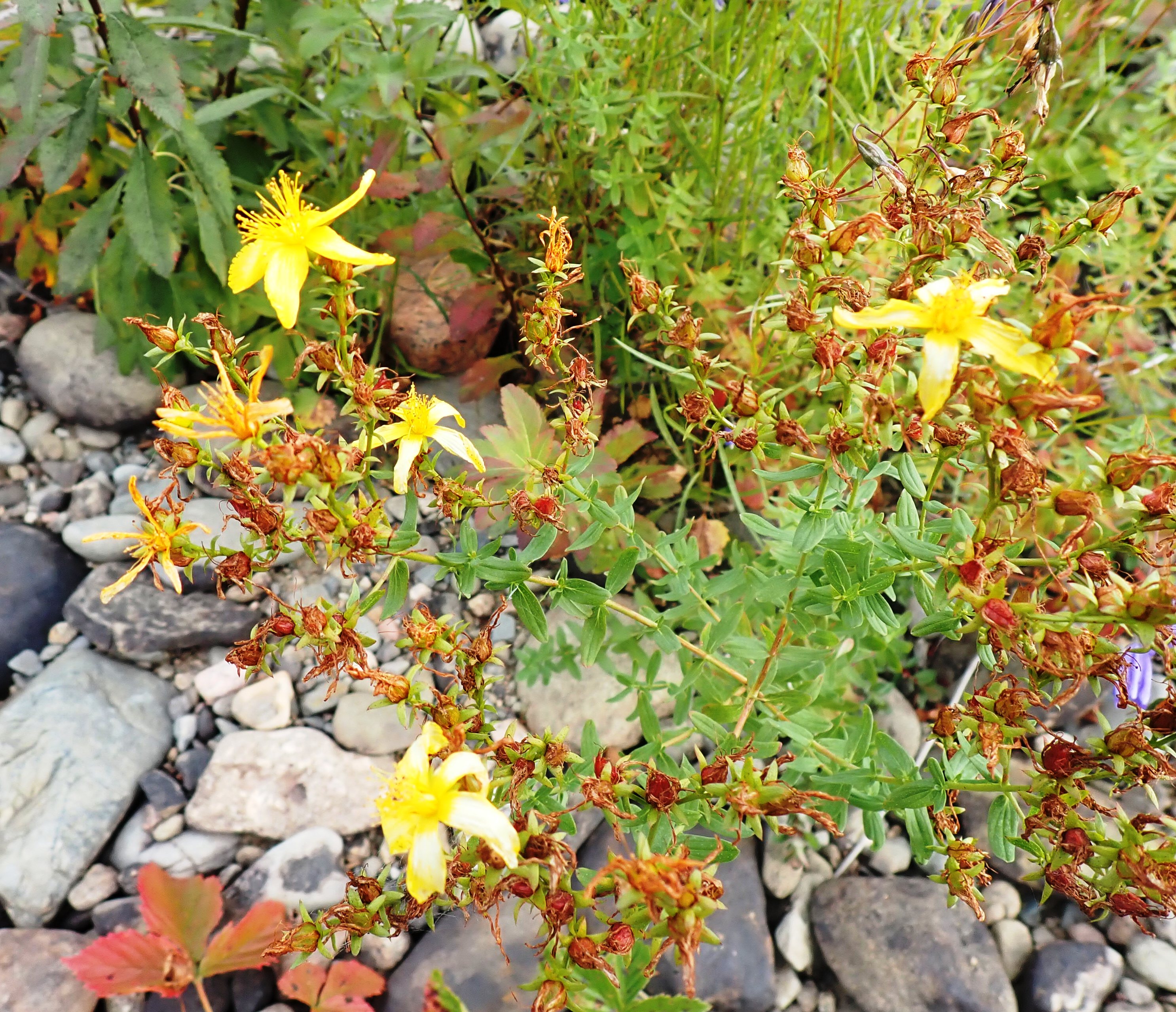
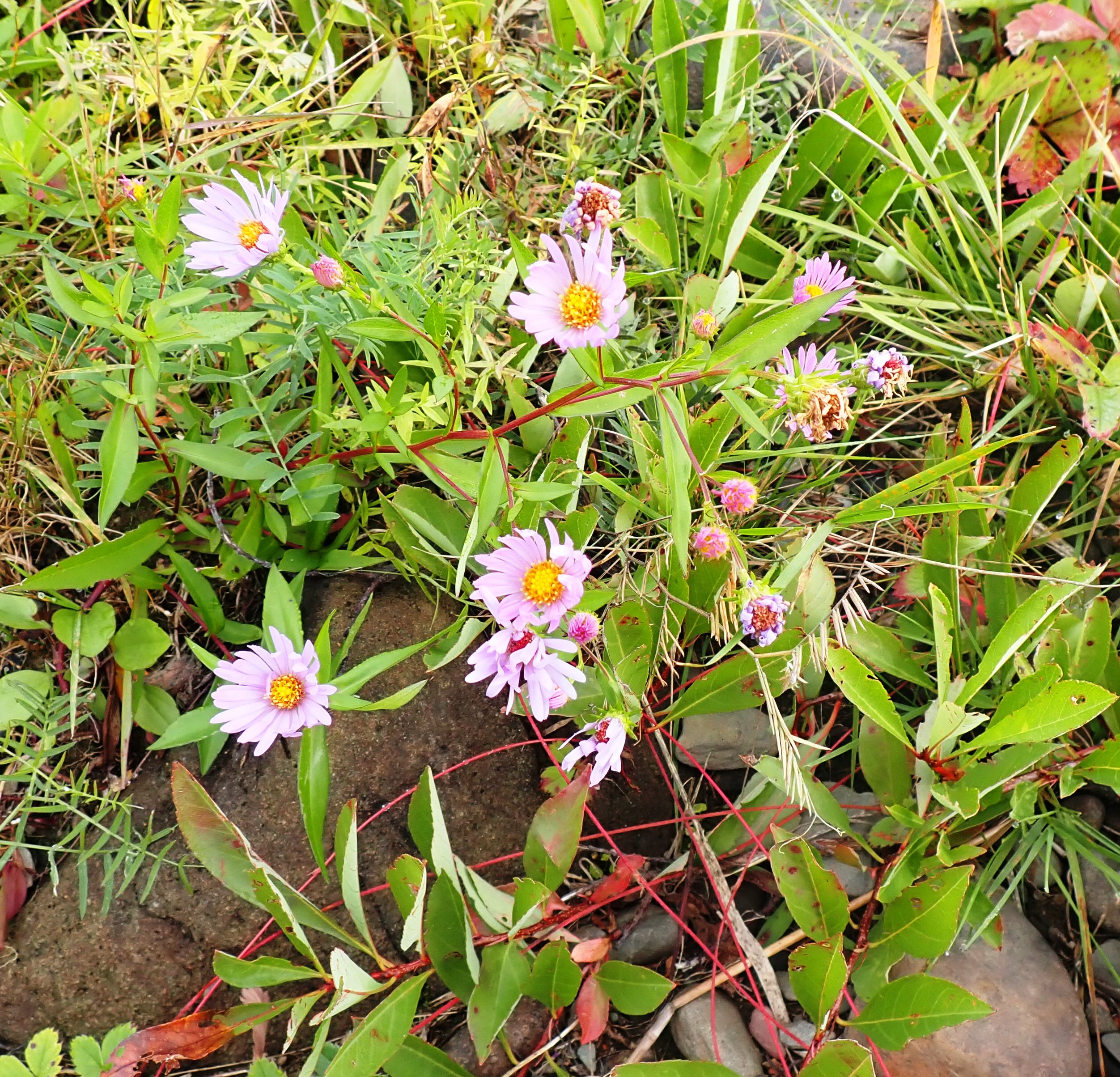
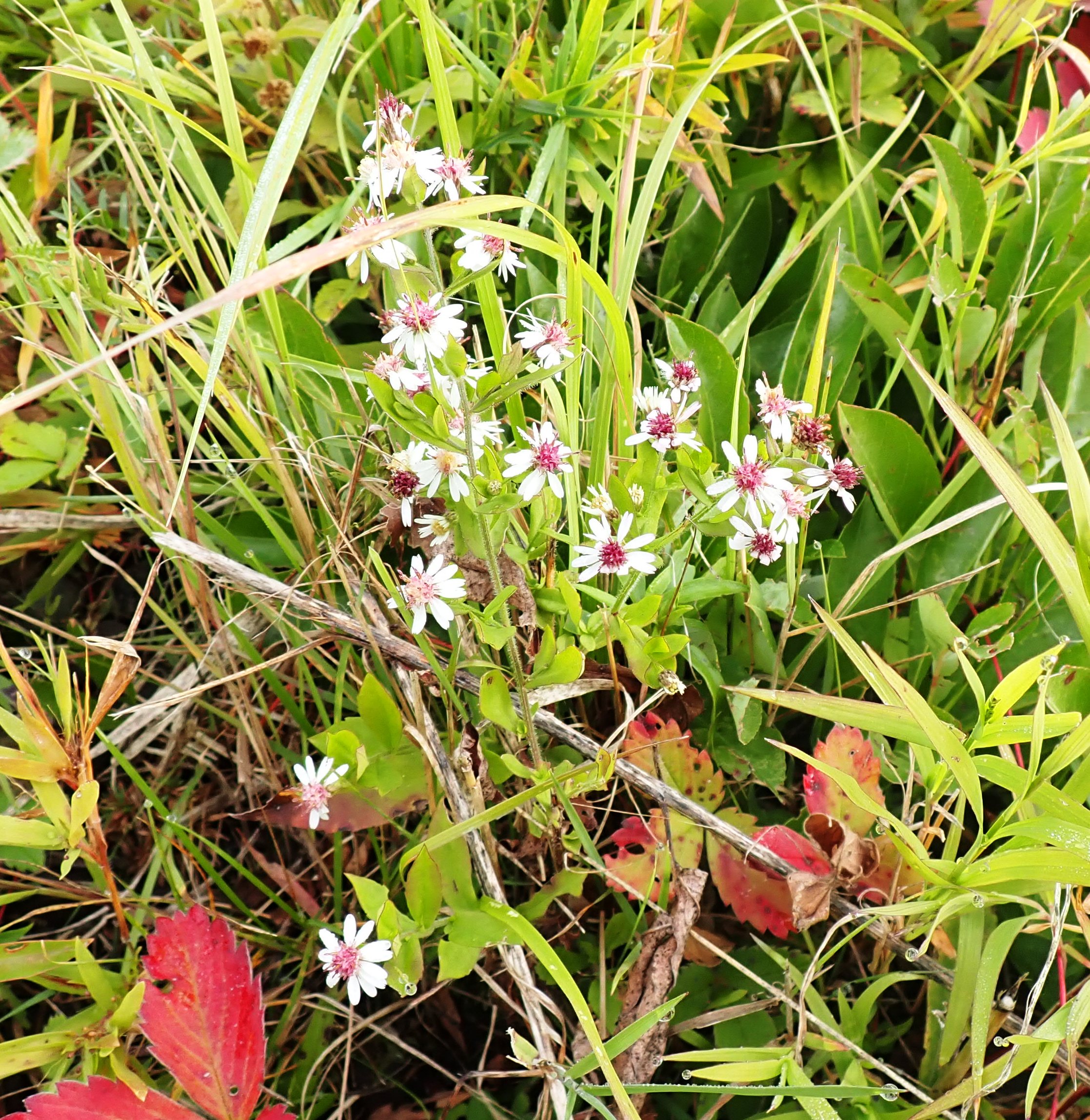
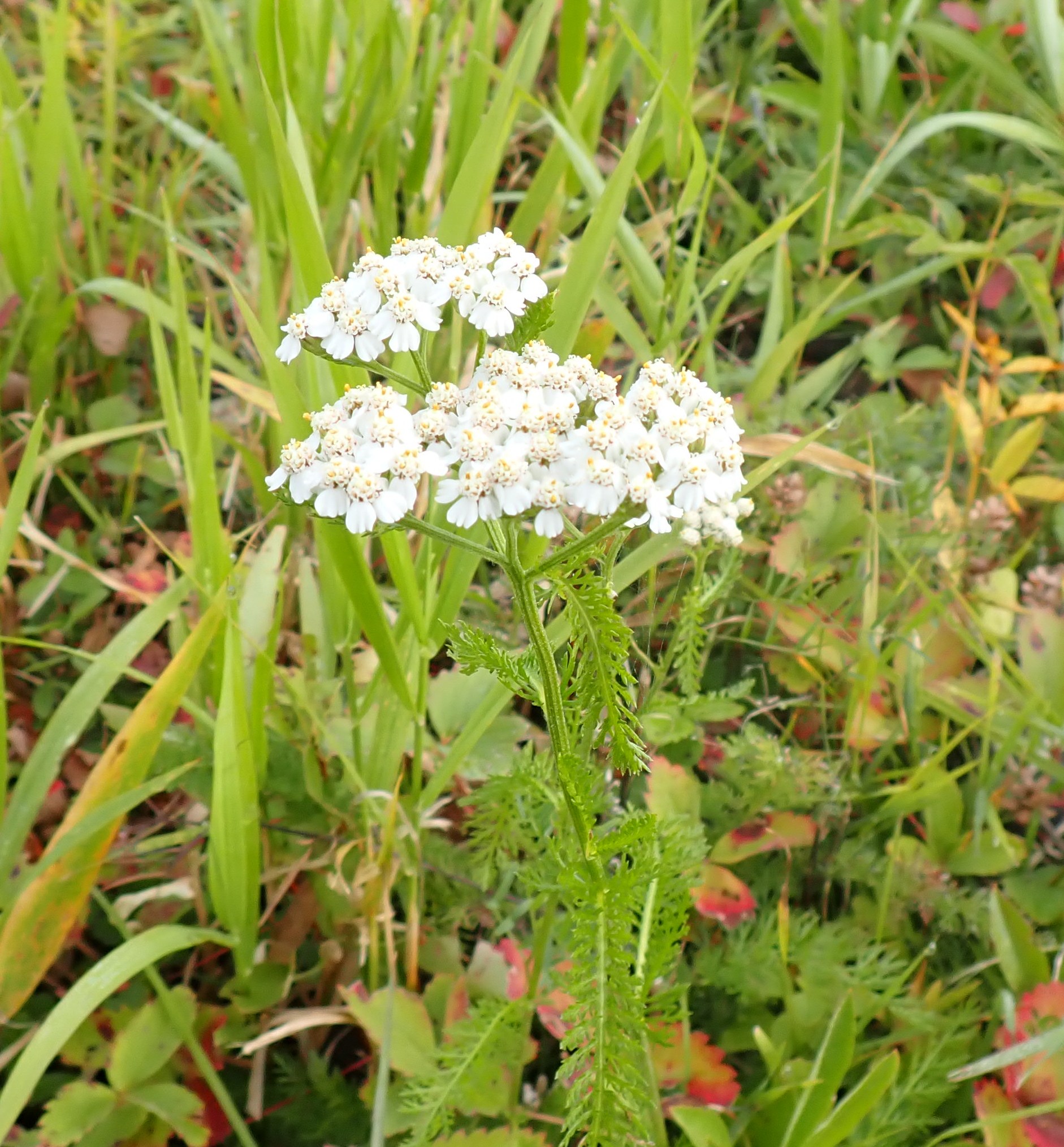
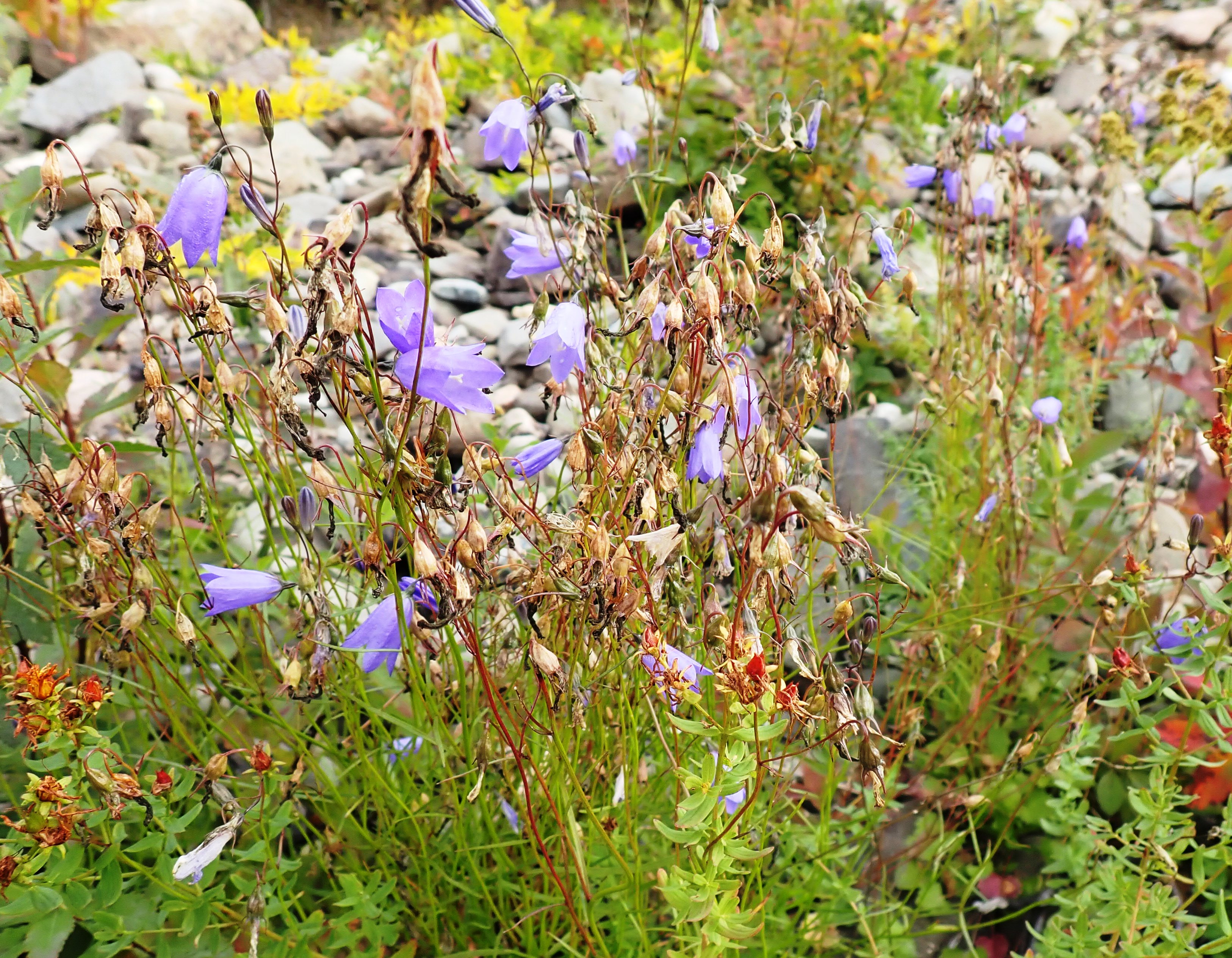
wonderful report!!
Ken Cogswell
Thanks Ken. I though a lot this fall about your observations up in the headwaters. We had the best traveling water for the fish that the Cains has offered in several years. After the first week in September the Cains had pretty good water all the time. At the end of August there were a lot of fish strung out between Black Brook and Salmon Brook that were destined for Cains headwaters. I imagine that there is some decent spawning activity going on up there about now. I wish I was there to see some of it.
To Ken Cogswell: It was really nice to meet you and your wife on the trail to Gordon Brook a couple of weeks ago. In my first year, I’ve met lots of nice people on the Cains. Have a good winter and see you next year!
Brad:
Glad you had good conditions after I left. Had a blast and can’t wait for next year. I’ll send your jungle cock featthers to ME soon. Sit down, relax, spend some time with mama and have a good winter. I’m sure you have projects !!! Rick
Thanks Rick. Enjoy Florida.
Brad,
Thanks for the encouraging report. Fished Little Sou’west 9/26-10/11. Fair results. Several grilse.
See you in Freeport.
Roger Earle
Thanks Roger.
Brad: Thanks for the roundup and thanks for your kind responses during the season. The glass is always half full for me and I look forward to another year with my son and friends in Boisetown.
Be well.
JCW
James – yeah, the buddies, meals, cocktails etc. are a very big part of the whole program. By the end of the season I really need a rest.
Thanks for the wrap up Brad. I appreciate your last paragraph, we have a great sport, practiced in a beautiful place, and, if we’re lucky, with great friends. As another correspondent said, I’m a glass half full guy. I caught my first Cains salmon this fall, a very lively grilse at Acadia Bridge. My friends and I also hooked salmon further up river from there, though alas not at the pool in front of Wildcat Camp! I think if I had stayed for the last two days of season I might have made that happen with that last pulse of good rain. The first year of owning the camp on the Cains is winding down but I’m very happy to have joined the community of people associated with this cool river. All the best for the winter and I’m looking forward to getting a copy of the new book. The map I bought has a good spot in my basement bar. All the best for the winter.
Thanks for your comment Terry. Terrific that you got a fish at Acadia this fall,and that you are enjoying your new camp. I’m sure that salmon are all over those upper stretches of the river now. Looks like another good shot of rain coming today. That will help get those spawning fish up and over any beaver dams that are blocking the brooks.
Hi Bradd, nice summation of your experiences this year. I fished in Boisetown with Renate Bullock and Vince Swazy from October 6th thru the 12th. Our group of 3 hooked 4 fish, 3 salmon and 1 grilse. The prior 2 weeks fishing was slightly better with 4 anglers hooking about 15-20 fish. This year was the best water conditions I have fished in my 30 years fishing this area of the river. The fishing was very disappointing to say the least. There is just not enough fish running to provide smidgen of good fishing. We seldom saw fish showing and the fish we did catch were pleasant surprises. DFO Trap numbers may not precisely measure the total abundance of the run but they certainly should show an accurate portrayal of the trend. The numbers don’t lie. The run’s precipitous decline started in 2012 with a poor grilse run which was 75% lower than the previous 17 year average. Since then it has remained near that reduced level while the MWS number has slowly declined in the total river to this years pathetic 268 a 71% decline over the 17 year pre 2012 average. What other major salmon river in North America has seen such a precipitous decline? None!! What is different about the Miramichi? A Striped Bass explosion!! When did the Striped Bass explosion reach significant numbers? 2011! Everyone needs to get behind ASF’s push to lower the striped bass population and MSA needs to stop screwing around with their to little to late SAS program because if we don’t DFO’s next act will be to move to classify the Miramichi Salmon an endangered species or whatever the Canadian equivalent is!
William – I agree completely with your sentiments up to the points about the ASF and the MSA. I have been deeply involved with the MSA for years. Mark Hambrook at the MSA was the first to recognize the striped bass predation of Atlantic Salmon smolts, and he has been the very top advocate for more aggressive striped bass regulations. The MSA has also been at least an equal partner with the ASF in the studies on the river that show where smolts are being intercepted by striped bass. Most or all of the watershed board members that have tried very hard to get DFO off the dime on striped bass are also MSA board members. The only fault I can find with MSA on all this is that they just aren’t as good about blowing their own horn as they should be.
Secondly, I feel that the MSA and the other members of the CAST program are dead on with the SAS approach. The UNB scientists that designed the SAS program realize that it is not the long term answer for the river. Not that it is bad to allow the SAS fish to spawn, but because it shouldn’t be necessary. It now appears that it may very well be necessary, though, to keep the Miramichi from joining the long list of New Brunswick rivers where Atlantic salmon are functionally extinct. The several thousand adult salmon that could have spawned in the NW Miramichi this past fall would have provided a big shot in the arm to that river’s spawning stock.
We need to take both approaches. Lower the population level of striped bass and get off the dime with the CAST SAS program. Brad
Brad, I agree MSA has done a lot of good things with ASF but I just don’t see them leading them leading the charge against DFO’s management of the Striped Bass population or more appropriately lack of Management. ASF’s report this spring was spot on with the recognition that the attempts to just add more smolts without doing anything to reduce the Bass smolt predation first was not attacking most important part of the problem. In addition it adds that SAS is a completely unproven technique especially on a large scale and as proposed has a 10 year horizon just to determine whether or not it might be successful. My own research of SAS has uncovered only one program, outside of NB, that has shown positive results. It however relied on hatcheries that used water from the exact stream supplemented and was done on a very small scale to improve a relatively small endangered population. We don’t have 10 years and reducing the population of adult spawning bass could be done quickly. I quote the ASF article “Positive change on striped bass is a fisheries management decision away, but progress has stalled. Efforts can be revived tomorrow and ASF is prepared to work
hard with all our partners to drive this change. For each 100-smolt spared, 2-3 adults will return from the sea”. BTW I would also like to add “god bless you” you are currently the only source of reliable information on web about what is going on with this fishery. I hope you keep up the great work!! Bill
Hi Brad
You put your time in and was rewarded with some nice fish this fall
especially the 40” + salmon!
Thank you for the fall report.
Don Olen
Thanks Don. I had a couple of those, and was very grateful for them both. We are always haunted by the ones that we lose. On the next to last day my friend Pete Howell was fishing at Black Brook’s Cain’s River pool when they he hooked, and finally lost what he says was a monster. Pete had caught an 18 pounder early in the week, and knows what a large salmon is… The one that I hooked in the Brophy Pool the day of Dorian’s rain swam straight up the channel of the pool hugging the bottom, and it felt absolutely indomitable. Unfortunately the hook pulled. Certainly the Cains still has some really large salmon in that fall run.
Brad,
I spent 34 years fishing the last week of September on the SWM and the Cain’s without a miss. This year I did not return. The Clarion call went out in 2012 and nothing has changed. There are thousands of Sports from around the world who love this water system and an economy for an entire valley that depends on its success. Sadly, as we discovered years ago when a group tried to get the old bridge piers removed at the mouth of the Cain’s, the Government of the Province could care less about the river and all whom she takes care of. The very sad truth of the matter is that this river is now past the point of recovery. You will not find an example anywhere of an Atlantic Salmon river whose population has crashed so precipitously ever recovering. In fact when you look at all the negative factors and are brutally honest with yourself the inevitable is less than 5 years away. The Miramichi is on life support as an Atlantic Salmon river with a sustainable stock and by 2023 or 2024 will be dead. No amount of action now can save it. You need native stock and complete elimination of all predatory elements which have contributed to the disaster to have an eyelash of a chance for recovery and you know in your heart that is an impossible wish given the complete indifference and hubris which infect those government officials whose job it has been to steward this incredible resource. How very sad for all those wonderful people and families who have given their lives for the river. Herb Wade, Charlie Wade, Willy, Malcom, and all the legends of the past are in anguish.
John – I hope that it is not quite as bad as that. Other rivers where salmon have disappeared had some fatal flaw like the acid rain effect on the Gulf of Maine rivers, or a big hydro project like the Saint John. The Miramichi is still quite pristine, has great spawning gravel, and is still producing lots of parr. I’m still hopeful that the situation at sea will change, the striped bass numbers will decline, and things will get better. Perhaps that won’t happen, but I don’t see why it can’t and I’m going to hope for that and do what I can to help it. Brad